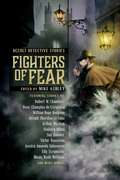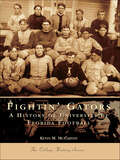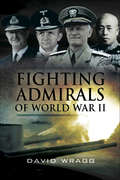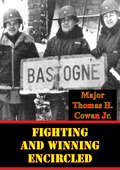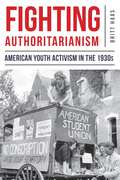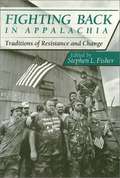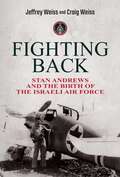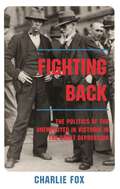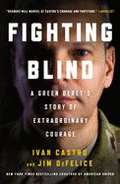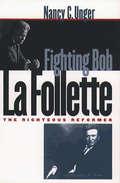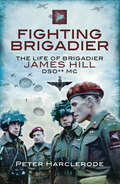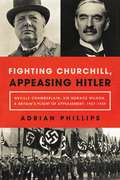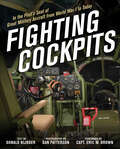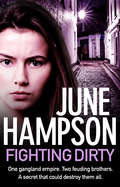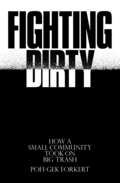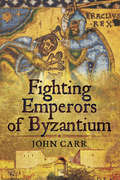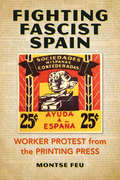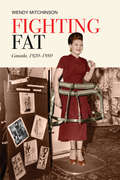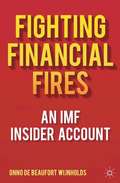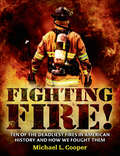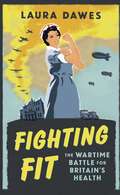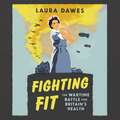- Table View
- List View
Fighters of Fear: Occult Detective Stories
by Mike AshleyA Retrospective Collection of Classic Occult and Supernatural Detective Stories by Some of the Field&’s Greatest and Best-Known Weird Fiction Authors Since the gaslit nights at the end of the nineteenth century, the occult detective has been a beloved and recurring archetype. Mixing the best aspects of the detective tale and weird or supernatural fiction, and capitalizing in part on the massive popularity of Sherlock Holmes, these stories portrayed men and women pitted against surreal and horrifying foes, usually with little to defend them but their own savvy, experience, and know-how. From William Hope Hodgson&’s Thomas Carnacki, to Seabury Quinn&’s fearless Frenchman Jules de Grandin, to Jessica Salmonson&’s Penelope Pettiweather, the occult detective has taken a variety of forms, investigated a wide array of supernatural and otherworldly cases, and entertained generations of readers. This new collection compiles thirty-one all-time classic occult detective stories as it traces the genre&’s growth from its nineteenth-century origins to the late twentieth century, showcasing the work of acclaimed pioneers of weird tales alongside cult favorites and exciting modern talents. So, step into the shadows, join us on this journey into the dark, and become a fighter of fear . . .CONTENTS Introduction, Mike Ashley Green Tea, Joseph Sheridan Le Fanu The Shining Pyramid, Arthur Machen The Haunted Child, Arabella Kenealy The Mystery of the Felwyn Tunnel, L. T. Meade & Robert Eustace The Story of Yand Manor House, E. & H. Heron The Tapping on the Wainscott, Allan Upward Samaris, Robert W. Chambers The Whistling Room, William Hope Hodgson The Woman with the Crooked Nose, Victor Rousseau The Sorcerer of Arjuzanx, Max Rittenberg The Ivory Statue, Sax Rohmer The Stranger, Claude & Alice Askew The Swaying Vision, Jessie Douglas Kerruish The Sanatorium, F. Tennyson Jesse The Villa on the Borderive Road, Rose Champion de Crespigny The Room of Fear, Ella Scrymsour The Seven Fires, Philippa Forest The Subletting of the Mansion, Dion Fortune The Jest of Warburg Tantavul, Seabury Quinn The Soldier, A. M. Burrage The Horror of the Height, Sydney Horler The Mystery of Iniquity, L. Adams Beck The Thought-Monster, Amelia Reynold Long The Shut Room, Henry S. Whitehead Dr. Muncing, Exorcist, Gordon MacCreagh The Case of the Haunted Cathedral, Margery Lawrence The Shonokins, Manly Wade Wellman The Dead of Winter Apparition, Joseph Payne Brennan The Garden of Paris, Eric Williams St. Michael and All Angels, Mark Valentine Jeremiah, Jessica Amanda Salmonson
Fightin' Gators: A History of the University of Florida Football (Campus History)
by Kevin M. McCarthyExperience the University of Florida football program's fascinating 20th century journey, one that has brought enjoyment to millions and national recognition to the school.The University of Florida, the state's oldest and largest university, is recognized today as one of the country's most academically diverse public institutions. Though able to trace its history to 1853, the school did not begin its popular football program until the first few years of the 20th century. The program has had its share of scandals and embarrassments over time, but it has also produced two Heisman Trophy winners, a national champion, numerous players drafted into the professional ranks, and a visibility that consistently ranks the team in the top five in the country. Now attracting 85,000 fans to each of its home games, the Gators' football program has become a vital part of the University of Florida. When the team won the national championship in 1996, no one could have predicted such success just 90 years earlier. Fortunately, that journey through the last century has been captured in great photographs that include formal portraits of teams, action shots on the field, views of the stadium simply referred to as "The Swamp" by fans, and snapshots from every decade. These images tell the story of the birth and growth of a football team.
Fighting Admirals of World War II
by David WraggSeapower was a crucial element in the outcome of the Second World War. The U-Boat campaign almost brought Britain to her knees; the Arctic convoys were crucial to keeping Russia in the War; Pearl Harbor brought America into the conflict with massive repercussions; allied naval supremacy made the D-Day landings possible.This book examines in detail the key naval commanders of both sides including five British (Pound, Cunningham, Ramsay, Horton, Somerville) and five US admirals (King, Nimitz, Spruance, Halsey, Fletcher), three German (Raeder, Doenitz, Lutjens) three Japanese (Yamamato, Nagumo, Koga) and two French (Darlan, de la Borde), the latterjustified by the problems faced by Vichy France, including the courageous decision to scuttle the fleet rather than let it fall into German hands in late 1942. In selecting the list, the author has made their decisive role in the war the only criterion.
Fighting And Winning Encircled
by Major Thomas H. Cowan Jr.This monograph answers the question "What must an encircled unit be provided and do in order to successfully hold?" Following the end of the Cold War and the subsequent drawdown, the United States adopted a military strategy of force projection. Given this new strategy, any future adversary of the United States is likely to attack early to deny the points of entry into the theater. The initial deploying U.S. forces must be prepared to fight and defend these points of entry until relieved or reinforced.The author uses historical examples of encirclements from World War II, Korea, and Vietnam to support lessons learned during a major simulation exercise in which a division had to fight encircled. The report presents the preconditions that an operational commander must set for the encircled unit which are: provide the necessary combat power, apply external pressure on the enemy, maintain air superiority, provide logistical support, and give the tactical commander freedom of action. Then the report takes a systems perspective to analyze the tactical commander's mission using the battlefield operating systems as a tool. The author presents the specific tasks the commander must execute and the concepts that he must consider. If the operational commander does not provide the necessary preconditions for success or the tactical commander does not take a systems perspective when setting up the defense, the encircled unit will fail.
Fighting Authoritarianism: American Youth Activism in the 1930s
by Britt HaasDuring the Great Depression, young radicals centered in New York City developed a vision of and for America, molded by their understanding of recent historical events, in particular the Great War and the global economic collapse, as well as by the events unfolding both at home and abroad. They worked to make their vision of a free, equal, democratic society based on peaceful coexistence a reality. Their attempts were ultimately unsuccessful but their voices were heard on a number of important issues, including free speech, racial justice, and peace. A major contribution to the historiography of the era of the Great Depression, Fighting Authoritarianism provides a new and important examination of U.S. youth activism of the 1930s, including the limits of the New Deal and how youth activists continually pushed FDR, Eleanor Roosevelt, and other New Dealers to do more to address economic distress, more inclusionary politics, and social inequality. In this study, author Britt Haas questions the interventionist versus isolationist paradigm in that young people sought to focus on both domestic and international affairs. Haas also explores the era not as a precursor to WWII, but as a moment of hope when the prospect of institutionalizing progress in freedom, equality, and democracy seemed possible.Fighting Authoritarianism corrects misconceptions about these young activists’ vision for their country, heavily influenced by the American Dream they had been brought up to revere: they wanted a truly free, truly democratic, and truly equal society. That meant embracing radical ideologies, especially socialism and communism, which were widely discussed, debated, and promoted on New York City college campuses. They believed that in embracing these ideologies, they were not turning their backs on American values. Instead, they believed that such ideologies were the only way to make America live up to its promises. This study also outlines the careers of Molly Yard, Joseph Lash, and James Wechsler, how they retracted (and for Yard and Lash, reclaimed) their radical past, and how New York continued to hold a prominent platform in their careers. Lash and Wechsler both worked for the New York Post, the latter as editor until 1980. Examining the Depression decade from the perspective of young activists highlights the promise of America as young people understood it: a historic moment when anything seemed possible.
Fighting Back in Appalachia: Traditions of Resistance and Change
by Stephen L. FisherEssays explore various forms of resistance in Appalachia including community organizing and labor unions.
Fighting Back: Stan Andrews and the Birth of the Israeli Air Force
by Jeffrey Weiss Craig WeissFighting Back is the story of Stan Andrews, an assimilated American Jew and World War II veteran who became one of the first fighter pilots in the history of the Israeli Air Force.In 1948, Stan Andrews left a comfortable postwar life in Los Angeles to travel to the war-torn Middle East, where a four-front Arab invasion threatened to destroy the newly-declared State of Israel. There he joined the Israeli Air Force and became one of its first fighter pilots. Andrews was an unexpected volunteer for the fight for a Jewish state. He was many things—an artist, writer, assimilated Jew, ladies&’ man, pilot, and combat veteran of the Pacific War. He had previously been aloof from the struggle for Jewish independence but found himself so roused by the anti-Semitism of 1940s America that he decided to go to Israel and risk everything. Stan made the most of his time in Israel, serving in fighter and bomber squadrons and leaving his mark on an Israeli Air Force that has since become the stuff of legend.
Fighting Back: The Politics of the Unemployed in Victoria in the Great Depression
by Charlie FoxWork for the Dole is not a new idea. It was introduced in Victoria in 1932 and became one of the battlegrounds of unemployed politics. The provision and administration of sustenance, relief work, eviction of tenants from their homes, the issue of free speech—these were the major issues confronting unemployed workers and their families and organisations, and they fought successive governments over each one. Written in a pleasingly clear and accessible style, this absorbing work shows how complex unemployed politics was, and situates it in the long history of agitation by unemployed workers. It takes issue with the prevailing historical orthodoxy that unemployed workers in Australia during the Great Depression were introspective, politically apathetic and concerned only with survival. It shows that, to the contrary, they were active, organised and remarkably successful in their aims. It also shows that government unemployment relief was as much a product of this agitation as it was of government policies and preferences. Yet the movement was always pulled in other direction; by the hunger and poverty of its members, by their need simply to survive, by the disengagement that accompanies individual powerlessness and by resignation in the face of such an incomprehensible disaster. That a creative, often extensive and vigorous unemployed movement could exist in such circumstances, in a decade of the worst poverty Australia has known, is surely a tribute to the courage and resistance of the men and women who made unemployed politics. Fox's book takes a complex look at the actual politics of the unemployed in the Great Depression, a subject which, for various reasons. Hence it represents a substantial revision of the existing historiography.
Fighting Blind: A Green Beret's Story Of Extraordinary Courage
by Jim DeFelice Ivan Castro Ivan Castro and Jim DeFeliceFighting was a practiced routine for Lieutenant Ivan Castro. But when a mortar round struck the rooftop of his sniper’s post in Iraq, he found himself in a battle more difficult than even he could have imagined. The direct hit killed two other soldiers and nearly claimed Castro’s life as well. Mangled by shrapnel and badly burned, Castro was medevac’d to Germany more dead than alive. His lungs were collapsed. He couldn’t hear. One eye had been blown out, the nerve to the other severed. In the weeks and months that followed, Castro would find that physical darkness was nothing compared to the emotional darkness of loss and despair. Desperate for a reason to live, he eventually fought his way back to health through exercise and a single-minded goal: running a marathon. Once he set his course, there was no stopping him. Stubborn to a point that at times bordered on insanity, he managed not only to recover but to return to active duty. Since 2007, he has run over two dozen marathons, including the Boston Marathon in 2013, where he was one of the runners diverted when the bombs exploded. Today, Castro helps prepare soldiers for combat, working exactly as if he were “sighted.” Fighting Blind, this frankly told account of his struggle through adversity, the highs and lows and the always bumpy road in between, is a story of hope and perseverance against the odds: an Unbroken for the present generation.
Fighting Bob La Follette
by Nancy C. UngerRobert "Fighting Bob" La Follette (1855-1925) was one of the most significant leaders of American progressivism. Nancy Unger integrates previously unknown details from La Follette's personal life with important events from his storied political career, revealing a complex man who was a compelling mixture of failure and accomplishment, tragedy and triumph.Serving as U.S. representative from 1885 to 1891, governor of Wisconsin from 1901 to 1906, and senator from Wisconsin from 1906 to his death in 1925, La Follette earned the nickname "Fighting Bob" through his uncompromising efforts to reform both politics and society, especially by championing the rights of the poor, workers, women, and minorities.Based on La Follette family letters, diaries, and other papers, this biography covers the personal events that shaped the public man. In particular, Unger explores La Follette's relationship with his remarkable wife, feminist Belle Case La Follette, and with his sons, both of whom succeeded him in politics. The La Follette who emerges from this retelling is an imperfect yet appealing man who deserves to be remembered as one of the United States' most devoted and effective politicians.
Fighting Brigadier: The Life of Brigadier James Hill DSO** MC
by Peter HarclerodeIn the 1930s James Hill was forced to leave the Army because he was under 26 when he married. Recalled to the colors, he won his MC with the BEF in 1940. He was one of the first to volunteer for airborne forces and became second-in-command of 1 PARA. He was in the thick of the expansion of Airborne forces in 1941-42 and took command of 1 PARA in North Africa, winning his first DSO. He converted 10th Bn The Essex Regiment to 9 PARA and later in 1943 took command of 3 Parachute Brigade, playing a major role in the D-Day Landings. Wounded twice, his Brigade captured the key Merville Battery.The Brigade recovered to England in September 1944 before returning to Europe to contain the German winter Bulge offensive. In March 1945 his Brigade played a key role in the Rhine Crossing and raced east to block the Russian advance on Denmark.Post war Brigadier Hill was a leading figure in the Parachute Regiment and revered by fellow Paras. He died in 2006.
Fighting Churchill, Appeasing Hitler: Neville Chamberlain, Sir Horace Wilson, And Britain's Plight Of Appeasement: 1937-1939
by Adrian PhillipsA radically new view of the British policy of appeasement in the late 1930s, identifying the individuals responsible for a variety of miscalculations and moral surrender that made World War II inevitable. Appeasement failed in all its goals. The kindest thing that can be said of it is that postponed World War II by one year. Its real effect was to convince Hitler and Mussolini that Britain was weak and afraid of confrontation, encouraging them to ever-greater acts of aggression. The turning point of the Czech crisis in September 1938 came when Wilson saw Hitler on his own and left him convinced that Britain was bluffing and would not go to war to defend Czechoslovakia. The dismemberment of Czechoslovakia that followed was not the end of appeasement. The Anglo-German Declaration was Chamberlain’s personal vanity project but both Chamberlain and Wilson believed that it genuinely brought "peace for our time." Chamberlain and Wilson blindly pursued bilateral friendship between Britain and the dictators and ferociously resisted alternative policies such as working with France, the Soviet Union, or the U.S. to face down the dictators. They resisted all-out rearmament which would have put the economy on a war footing. These were all the policies advocated by Winston Churchill, the most dangerous opponent of appeasement. Churchill was a hated figure for Chamberlain and Wilson. They could not accept Churchill’s perception that that Hitler was the implacable enemy of peace and Britain, and opposing him became an end in itself for them. Churchill and Wilson had been bitter adversaries since early in their careers because of an incident that Fighting Churchill, Appeasing Hitler reveals publicly for the first time. Chamberlain had a fraught relationship with Churchill long before appeasement became an issue. Neither Chamberlain nor Wilson had any experience of day-to-day practical diplomacy. Both thought that the dictators would apply the same standards of rationality and clarity to the policies of Italy and Germany that applied in Britain. They could not grasp that Fascist demagogues operated in an entirely different way to democratic politicians. The catastrophe of the Chamberlain/Wilson appeasement policy offers a vital lesson in how blind conviction in one policy as the only alternative can be fatally damaging.
Fighting Cockpits: In the Pilot's Seat of Great Military Aircraft from World War I to Today
by Dan Patterson Donald NijboerWhat was it like to sit in the pilot's seat and take control of a P-51 Mustang in World War II? What about an F-14 Tomcat at the height of the Cold War? Or a Lockheed Martin F-22 Raptor today? The cockpits of these fighter and bomber aircraft are revealed in Fighting Cockpits. Showcasing more than 50 of the world's most famous combat cockpits from early World War I aircraft to present-day fighters, this book includes more than 200 rich color photos from photographer Dan Patterson, as well as detailed history about combat cockpit development from aviation expert and historian Donald Nijboer.Presented in large-format, you'll be blown away by studio shot spreads of views from the cockpits, vintage photographs of the aircrafts in action, and modern photography of surviving crafts. This book will complete any history buff or aviation enthusiast's library.Aircraft include:Wind in the Wires: Nieuport 28, Royal Aircraft Factory S.E.5, Bristol F.2, Fokker Dr.I, Sopwith Camel, Sopwith Triplane, AEG G.IV, SPAD VII, Halberstadt CL.IV, Fokker D.VIIThe Rise of the Monoplane: Martin MB-2, Hawker Hind, Fiat CR.32, Boeing P-26 Peashooter, Curtiss F9C, Sparrowhawk, Vought SB2U Vindicator, Westland Lysander, PZL P.11World War II: Supermarine Spitfire, Messerschmitt Bf 109, Republic P-47 Thunderbolt, North American P-51 Mustang, Handley Page Halifax, Vickers Wellington, Focke-Wulf Fw 190 Wurger, Fairey Firefly, Fiat CR.42, Ilyushin Il-2 Sturmovik, Heinkel He 219 Uhu, Kawasaki Ki-45 Toryu, Curtiss SB2C Helldiver, Northrop P-61 Black Widow, Boeing B-17 Flying Fortress, Boeing B-29 Superfortress, Dornier Do 335 Pfeil, Messerschmitt Me 262 Schwalbe, Arado Ar 234 BlitzCold War to the Present: North American F-86 Sabre, Boeing B-52 Stratofortress, Grumman A-6 Intruder, General Dynamics F-111 Aardvark, Hawker Siddeley Harrier, McDonnell Douglas/Boeing F-15 Eagle, Grumman F-14 Tomcat, Fairchild Republic A-10 Thunderbolt II, General Dynamics/Lockheed Martin F-16 Fighting Falcon, Mikoyan MiG-29, Rockwell B-1 Lancer, Lockheed Martin F-117 Nighthawk, Lockheed Martin F-22 Raptor, Lockheed Martin F-35 Lightning II Joint Strike Fighter
Fighting Dirty
by June HampsonThe final, heart-pounding instalment in June Hampson's compelling gangland saga series.It's 1983 and Daisy Lane is battling to keep her son, Jamie, under some kind of control. His older brother Eddie is about to come out of prison after a stretch for manslaughter, and his release couldn't come soon enough. In Eddie's absence, Jamie has matured from a tearaway teenager to a hardened criminal with a psychotic edge to his character. He's responsible for the death of Roy's bit-on-the-side along with a string of other violent episodes. Only Eddie can keep his young brother from acting out his darkest desires. As Eddie emerges from prison, he finds that the world has moved on. The criminal underworld is tougher with fewer allegiances than ever before. Eddie decides to reject Roy's offer of help and instead go it alone, setting up his own gang - who plan the most audacious heist Britain has seen in decades. Will Eddie manage to pull it off? Or will his brother be his undoing?
Fighting Dirty
by June Hampson'She is giving Martina Cole a run for her money' - Amazon reviewONE GANGLAND EMPIRE. TWO FEUDING BROTHERS. A SECRET THAT COULD DESTROY THEM ALL.Daisy Lane is battling to keep her son, Jamie, under control. His older brother Eddie is about to come out of prison after a stretch for manslaughter, and his release couldn't come soon enough. In Eddie's absence, Jamie has matured from a tearaway teenager into a hardened criminal with a psychotic edge. He's responsible for the death of Roy's mistress along with a string of other violent episodes. Only Eddie can keep his young brother from acting out his darkest desires.As Eddie emerges from prison, he finds that the world has moved on. The criminal underworld is tougher with fewer allegiances than ever before. Eddie decides to reject Roy's offer of help and instead go it alone, setting up his own gang - who plan the most audacious heist Britain has seen in decades. Will Eddie manage to pull it off? Or will his brother be his undoing?If you like crime thrillers by Jessie Keane, Kimberley Chambers, Mandasue Heller and Martina Cole, you'll love Fighting Dirty, the gripping sixth and final novel in the Daisy Lane thriller series.Why readers love June Hampson's thrillers:'A cracking story' - THE BOOKSELLER'A rattling good read' Amazon review'The Daisy Lane books are all brilliant' - Amazon reviewer'This book is an emotional rollercoaster full of grit, violence, sadness, warmth, emotion and love' - Goodreads reviewer
Fighting Dirty: How a Small Community Took on Big Trash
by Poh-Gek ForkertFighting Dirty tells the story of how one small group of farmers, small-town residents, and Indigenous people fought the world’s largest waste disposal company to stop them from expanding a local dumpsite into a massive landfill. As one of the experts brought in to assess the impact the toxic waste would have on the community, Poh-Gek Forkert was part of the adventures and misadventures of their decades-long fight.
Fighting Emperors of Byzantium
by John CarThe Eastern Roman or 'Byzantine' Empire had to fight for survival throughout its long history so military ability was a prime requisite for a successful Emperor. John Carr concentrates on the personal and military histories of the more capable war fighters to occupy the imperial throne at Constantinople. They include men like it's founder Constantine I , Julian, Theodosius, Justinian, Heraclius, Leo I, Leo III, Basil I, Basil II (the Bulgar-slayer), Romanus IV Diogenes, Isaac Angelus, and Constantine XI. Byzantium's emperors, and the military establishment they created and maintained, can be credited with preserving Rome's cultural legacy and, from the seventh century, forming a bulwark of Christendom against aggressive Islamic expansion. For this the empire's military organization had to be of a high order, a continuation of Roman discipline and skill adapted to new methods of warfare. Thus was the Empire, under the leadership of its fighting emperors, able to endure for almost a thousand years after the fall of Rome.
Fighting Faiths: The Abrams Case, the Supreme Court, and Free Speech
by Richard PolenbergJacob Abrams et al. v. United States is the landmark Supreme Court case in the definition of free speech. Although the 1918 conviction of four Russian Jewish anarchists-for distributing leaflets protesting America's intervention in the Russian revolution-was upheld, Justice Oliver Wendell Holmes's dissenting opinion (with Justice Louis Brandeis) concerning "clear and present danger" has proved the touchstone of almost all subsequent First Amendment theory and litigation. <p><p>In Fighting Faiths, Richard Polenberg explores the causes and characters of this dramatic episode in American history. He traces the Jewish immigrant experience, the lives of the convicted anarchists before and after the trials, the careers of the major players in the court cases-men such as Holmes, defense attorney Harry Weinberger, Southern Judge Henry DeLamar Clayton, Jr., and the young J. Edgar Hoover-and the effects of this important case on present-day First Amendment rights.
Fighting Fascist Spain: Worker Protest from the Printing Press
by Montse FeuIn the 1930s, anarchists and socialists among Spanish immigrants living in the United States created España Libre (Free Spain) as a response to the Nationalist takeover in their homeland. Worker-oriented and avowedly antifascist, the grassroots periodical raised money for refugees and political prisoners while advancing left-wing culture and politics. España Libre proved both visionary and durable, charting an alternate path toward a modern Spain and enduring until democracy's return to the country in 1977. Montse Feu merges España Libre's story with the drama of the Spanish immigrant community's fight against fascism. The periodical emerged as part of a transnational effort to link migrants and new exiles living in the United States to antifascist networks abroad. In addition to showing how workers' culture and politics shaped their antifascism, Feu brings to light creative works that ranged from literature to satire to cartoons to theater. As España Libre opened up radical practices, it encouraged allies to reject violence in favor of social revolution's potential for joy and inclusion.
Fighting Fat: Canada, 1920-1980
by Wendy MitchinsonWhile the statistics for obesity have been alarming in the twenty-first century, concern about fatness has a history. In Fighting Fat, Wendy Mitchinson discusses the history of obesity and fatness from 1920 to 1980 in Canada. Through the context of body, medicine, weight measurement, food studies, fat studies, and the identity of those who were fat, Mitchinson examines the attitudes and practices of medical practitioners, nutritionists, educators, and those who see themselves as fat. Fighting Fat analyzes a number of sources to expose our culture’s obsession with body image. Mitchinson looks at medical journals, both their articles and the advertisements for drugs for obesity, as well as magazine articles and advertisements, including popular "before and after" weight loss stories. Promotional advertisements reveal how the media encourages negative attitudes towards body fat. The book also includes over 30 interviews with Canadians who defined themselves as fat, highlighting the emotional toll caused by the stigmatizing of fatness.
Fighting Financial Fires
by Onno de Beaufort WijnholdsA topical insider view of causes and consequences of financial crises since the Mexican collapse of 1995. The book includes a detailed exploration of recent and ongoing firestorms, including the near meltdown of the global financial system and the euro crisis and suggests ways to save the international financial and monetary system.
Fighting Fire!: Ten of the Deadliest Fires in American History and How We Fought Them
by Michael L. CooperFrom colonial times to the modern day, two things have remained constant in American history: the destructive power of fires and the bravery of those who fight them.Fighting Fire! brings to life ten of the deadliest infernos this nation has ever endured: the great fires of Boston, New York, Chicago, Baltimore, and San Francisco, the disasters of the Triangle Shirtwaist Factory, the General Slocum, and the Cocoanut Grove nightclub, the wildfire of Witch Creek in San Diego County, and the catastrophe of 9/11. Each blaze led to new firefighting techniques and technologies, yet the struggle against fires continues to this day. With historical images and a fast-paced text, this is both an exciting look at firefighting history and a celebration of the human spirit.
Fighting Fit: The Wartime Battle for Britain's Health
by Laura DawesAt the beginning of the Second World War, medical experts predicted epidemics of physical and mental illness on the home front. Rationing would decimate the nation's health, they warned; drugs, blood and medical resources would be in short supply; air raid shelters and evacuation would spread diseases; and the psychological effects of bombing raids would leave mental hospitals overflowing. Yet, astonishingly, Britain ended the war in better health than ever before. Based on original archival research and written with wit and verve, FIGHTING FIT reveals an extraordinary, forgotten story of medical triumph against the odds. Through a combination of meticulous planning and last-minute scrambling, Britain succeeded in averting, in Churchill's phrase, the 'dark curse' on the nation's health. It was thanks to the pioneering efforts of countless individuals - doctors, nurses, social workers, boy scouts, tea ladies, Nobel Prize winners, air raid wardens, housewives, nutritionists and psychologists - who battled to keep the nation fit and well in wartime. As Laura Dawes shows, these men and women not only helped to win the war, they paved the way for the birth of the NHS and the development of the welfare state.
Fighting Fit: The Wartime Battle for Britain's Health
by Laura DawesAt the beginning of the Second World War, medical experts predicted epidemics of physical and mental illness on the home front. Rationing would decimate the nation's health, they warned; drugs, blood and medical resources would be in short supply; air raid shelters and evacuation would spread diseases; and the psychological effects of bombing raids would leave mental hospitals overflowing. Yet, astonishingly, Britain ended the war in better health than ever before. Based on original archival research and written with wit and verve, FIGHTING FIT reveals an extraordinary, forgotten story of medical triumph against the odds. Through a combination of meticulous planning and last-minute scrambling, Britain succeeded in averting, in Churchill's phrase, the 'dark curse' on the nation's health. It was thanks to the pioneering efforts of countless individuals - doctors, nurses, social workers, boy scouts, tea ladies, Nobel Prize winners, air raid wardens, housewives, nutritionists and psychologists - who battled to keep the nation fit and well in wartime. As Laura Dawes shows, these men and women not only helped to win the war, they paved the way for the birth of the NHS and the development of the welfare state.Read by Karen Cass, with an introduction read by Laura Dawes(p) 2016 Orion Publishing Group
